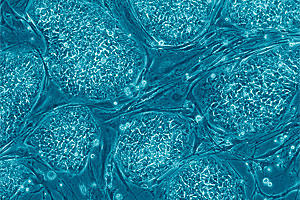The 20 genes the Japanese group identified are really master control genes. They are responsible for affecting how lots of other genes work. So, all a scientist would have to do is turn on these 20 genes in a skin cell and you'd get back to an ES cell. Sounds simple, right?
Unfortunately, scientists aren't very good at all at turning on a specific gene in a cell let alone 20. To get around this limitation, the scientists decided to add the genes to a skin cell using gene therapy.
Unfortunately, scientists can't easily add 20 genes to a cell with gene therapy either. This meant they had to find the bare minimum that might work. After much research, the group settled on four genes that could turn a skin cell into an ES cell.
Remember, this was all in mice. Now this same group (and another from the U.S.) has accomplished the same thing with a human cell. Both groups have taken a human skin cell, added four genes, and changed it into an ES cell.
We aren't going to be curing diseases with these cells quite yet though. When the Japanese group put the mouse cells back into a mouse, 20% of them developed cancer. This is probably due to one of the genes they used (myc), as well as the way they did their gene therapy (viral mediated).
The U.S. researchers who converted the human skin cell were able to do it without the myc gene. This tells us there are different sets of genes that can work in this process. Hopefully scientists can discover a set of genes and a way to get them into cells that won't cause cancer.
All this work got me to thinking. I wonder if scientists would have worked this hard to make ES cells from skin cells without George Bush's ban on ES cell research. They certainly would have got there eventually but would they have gotten there so quickly?
 Dr. Barry Starr is a Geneticist-in-Residence at The Tech Museum of Innovation in San Jose, CA.
Dr. Barry Starr is a Geneticist-in-Residence at The Tech Museum of Innovation in San Jose, CA.
latitude 37.3316, longitude -121.89
 Scientists can now turn skin cells into embryonic
Scientists can now turn skin cells into embryonic